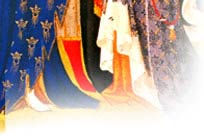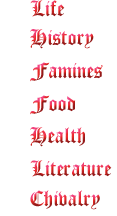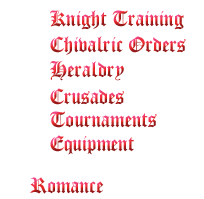 |
|||
  

|
Equipment Medieval knights were equipped with a variety of defensive garments and weapons, and trained to use nearly every possible offensive weapon of the Middle Ages. Early knights wore chain mail and tunics bearing the symbol of the order to which he belonged. By the 14th century, chain mail and tunics had evolved into full plate armor that protected the chest, arms, legs knees and feet. Quality plate armor was nearly impenetrable. The armor included a visored helmet that would often be festooned with decorative plumage. The knight's shield evolved to sport the heraldry found on the family crest, or coat of arms. Most shields were made of wood, the best being constructed of numerous wood strips with the grain of each layer running at 90-degree angles. Weapons included: Crossbow-one of the first banned weapons for
its "unchristianlike" characteristics of causing brutal death from far
away, thee ranged from simple hand-drawn devices, to larger ones requiring
levers, wheels and ratchets. They were replaced with the development of
the longbow. Daggers-made of all shapes and sizes often
encrusted with jewels. Blades varied from round, ice-pick like daggers
to those with three blades with made wounds nearly impossible to close.
Mace-a club-like weapon with blades or points
protruding from a heavy head. Each weapon was often given fanciful names
such as Morgenstern (Morning Star), Godendag (Good-day), or the dark humored
"Holy Water Sprinkler. Scimitar-a curved sword that broadened to a
point with one cutting edge. Two-handed sword-popular in the 15th century
and nearly 5-feet in length. It was used to make wide cutting sweeps in
open areas. War Hammer-a weapon similar to today's claw-hammer, but larger, with a handle nearly two feet long with a thrusting point affixed to the top. |
 |
|
 |
|||
 |
|||